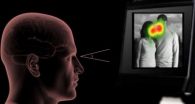(Press-News.org) Soul singer Betty Everett once proclaimed, "If you want to know if he loves you so, it's in his kiss." But a new study by University of Chicago researchers suggests the difference between love and lust might be in the eyes after all.
Specifically, where your date looks at you could indicate whether love or lust is in the cards. The new study found that eye patterns concentrate on a stranger's face if the viewer sees that person as a potential partner in romantic love, but the viewer gazes more at the other person's body if he or she is feeling sexual desire. That automatic judgment can occur in as little as half a second, producing different gaze patterns.
"Although little is currently known about the science of love at first sight or how people fall in love, these patterns of response provide the first clues regarding how automatic attentional processes, such as eye gaze, may differentiate feelings of love from feelings of desire toward strangers," noted lead author Stephanie Cacioppo, director of the UChicago High-Performance Electrical NeuroImaging Laboratory. Cacioppo co-authored the report, now published online in the journal Psychological Science, with colleagues from UChicago's Departments of Psychiatry and Psychology, and the University of Geneva.
Previous research by Cacioppo has shown that different networks of brain regions are activated by love and sexual desire. In this study, the team performed two experiments to test visual patterns in an effort to assess two different emotional and cognitive states that are often difficult to disentangle from one another—romantic love and sexual desire (lust).
Male and female students from the University of Geneva viewed a series of black-and-white photographs of persons they had never met. In part one of the study, participants viewed photos of young, adult heterosexual couples who were looking at or interacting with each other. In part two, participants viewed photographs of attractive individuals of the opposite sex who were looking directly at the camera/viewer. None of the photos contained nudity or erotic images.
In both experiments, participants were placed before a computer and asked to look at different blocks of photographs and decide as rapidly and precisely as possible whether they perceived each photograph or the persons in the photograph as eliciting feelings of sexual desire or romantic love. The study found no significant difference in the time it took subjects to identify romantic love versus sexual desire, which shows how quickly the brain can process both emotions, the researchers believe.
But analysis of the eye-tracking data from the two studies revealed marked differences in eye movement patterns, depending on whether the subjects reported feeling sexual desire or romantic love. People tended to visually fixate on the face, especially when they said an image elicited a feeling of romantic love. However, with images that evoked sexual desire, the subjects' eyes moved from the face to fixate on the rest of the body. The effect was found for male and female participants.
"By identifying eye patterns that are specific to love-related stimuli, the study may contribute to the development of a biomarker that differentiates feelings of romantic love versus sexual desire," said co-author John Cacioppo, the Tiffany and Margaret Blake Distinguished Service Professor and director of the Center for Cognitive and Social Neuroscience. "An eye-tracking paradigm may eventually offer a new avenue of diagnosis in clinicians' daily practice or for routine clinical exams in psychiatry and/or couple therapy."
INFORMATION:
Co-author Mylene Bolmont, a graduate student at the University of Geneva, Switzerland, contributed to the design of the study, conducted the testing and data collection for the study, and assisted with the data analyses.
Eye movements reveal difference between love and lust
2014-07-17
ELSE PRESS RELEASES FROM THIS DATE:
Atlantic salmon also show capacity to adapt to warmer waters
2014-07-17
Populations of Atlantic salmon have a surprisingly good capacity to adjust to warmer temperatures that are being seen with climate change, a group of scientists at the University of Oslo and University of British Columbia have discovered. The finding about Atlantic species adds to recent UBC-supported research on heat tolerance of Pacific salmon.
The new study, a collaboration between Norwegian and Canadian researchers, was recently published in Nature Communications. Funded by the Norwegian Research Council, it addressed questions around how climate change might affect ...
Eating lean beef daily can help lower blood pressure
2014-07-17
Contrary to conventional wisdom, a growing body of evidence shows that eating lean beef can reduce risk factors for heart disease, according to recent research by nutritional scientists.
"This research adds to the significant evidence, including work previously done in our lab, that supports lean beef's role in a heart-healthy diet," said Penny M. Kris-Etherton, Distinguished Professor of Nutrition, Penn State. "This study shows that nutrient-rich lean beef can be included as part of a heart-healthy diet that reduces blood pressure, which can help lower the risk for cardiovascular ...
Gut microbes turn carbs into colorectal cancer
2014-07-17
Colorectal cancer has been linked to carbohydrate-rich western diets, but the underlying mechanisms have been unclear. A study published by Cell Press July 17th in the journal Cell shows that gut microbes metabolize carbohydrates in the diet, causing intestinal cells to proliferate and form tumors in mice that are genetically predisposed to colorectal cancer. Treatment with antibiotics or a low-carbohydrate diet significantly reduced tumors in these mice, suggesting that these easy interventions could prevent a common type of colorectal cancer in humans.
"Because hereditary ...
Brown fat found to be at the root of cancer-related wasting syndrome
2014-07-17
VIDEO:
Many patients with advanced stages of cancer, AIDS, tuberculosis, and other diseases die from a condition called cachexia, which is characterized as a "wasting " syndrome that causes extreme thinness with...
Click here for more information.
Many patients with advanced stages of cancer, AIDS, tuberculosis, and other diseases die from a condition called cachexia, which is characterized as a "wasting" syndrome that causes extreme thinness with muscle weakness. ...
Obese women may have learning deficit specific to food
2014-07-17
Obese women have a deficit in reward-based learning, but only when food is involved. Importantly, say researchers who report their findings in the Cell Press journal Current Biology on July 17, those same women have no trouble at all forming accurate associations when the reward is money instead of food. The findings may lead to new, gender-appropriate ways to tackle the obesity epidemic.
"Our study shows that obesity may involve a specific impairment not in the processing of food itself, but rather in how obese individuals—or at least obese women—learn about cues in ...
Study identifies molecular key to healthy pregnancy
2014-07-17
Scientists have identified a crucial molecular key to healthy embryo implantation and pregnancy in a study that may offer new clues about the medical challenges of infertility/subfertility, abnormal placentation, and placenta previa.
Multi-institutional teams led by researchers at Cincinnati Children's Hospital Medical Center report their results in Cell Reports on July 17. The authors found that uterine expression of a gene called Wnt5a – a major signaling molecule in cell growth and movement in both embryo development and disease – is also critical to healthy embryo ...
First comprehensive library of master genetic switches in plants
2014-07-17
Researchers have created the first comprehensive library of genetic switches in plants, setting the stage for scientists around the globe to better understand how plants adapt to environmental changes and to design more robust plants for future food security.
The collection, which took more than 8 years and $5 million to create, contains about 2,000 clones of plant transcription factors, nature's genetic on/off switches. Manipulating these transcription factors enables scientists to improve plant traits such as cold resistance or seed quantity. The research will be published ...
Faithful cell division requires tightly controlled protein placement at the centromeres
2014-07-17
CAMBRIDGE, Mass. (July 17, 2014) – From fertilized egg to adult, the cells of the human body go through an astronomical number of divisions. During division of any of the body's roughly 30 trillion cells, DNA from the initial cell must be split precisely between the two resulting cells. Critical to successful cell division is the integrity of the centromere—a region of DNA on each chromosome where the cell division machinery attaches to segregate the chromosomes. For the segregation machinery to recognize this region, it must contain many copies of a pivotal protein known ...
One third of cancer patients are killed by a 'fat-burning' process termed 'cachexia'
2014-07-17
VIDEO:
One third of cancer patients are killed by a 'fat-burning' process known as cachexia.
Click here for more information.
Most cancer researchers are working on the biology of the tumour. However, Michele Petruzzelli, a member of Erwin Wagner's group at the Spanish National Cancer Research Centre (CNIO), has been looking for ways to attack the disease indirectly. He focused on the effects of tumours on the rest of the body, and not on the tumour itself. His work on the body's ...
Researchers discover new link between obesity, inflammation, and insulin resistance
2014-07-17
La Jolla, Calif., July 17, 2014 - A new study by researchers at Sanford-Burnham Medical Research Institute (Sanford-Burnham) has identified a new signal that triggers the events leading to insulin resistance in obesity. The signal causes inflammation in adipose tissue and leads to metabolic disease. The study, published July 17 in Cell Metabolism, suggests that blocking this signal may protect against the development of metabolic disease, type 2 diabetes, and other disorders caused by obesity-linked inflammation.
"We have uncovered a precise mechanism that explains how ...



